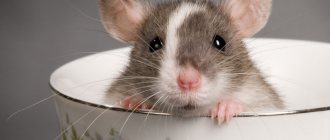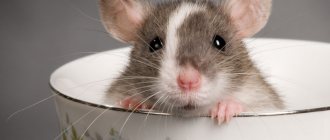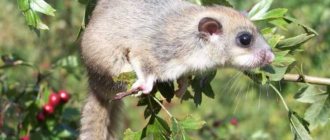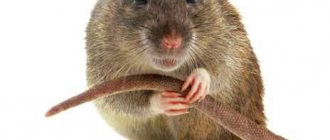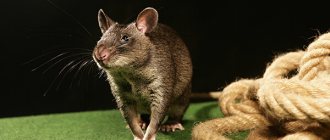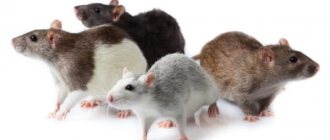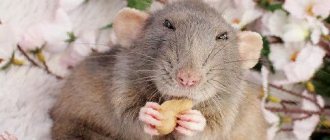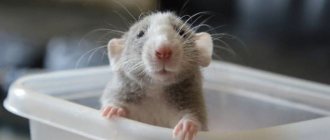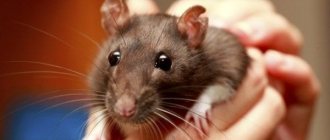Nobody knows when people first became acquainted with rats; this animal always lives next to us.
The rat belongs to the mammals, to the order - rodents, suborder - mouse-like. The most common animal on the planet is the rat.
Appearance of the rat, description and characteristics
The body of the rat is oval-shaped and stocky. The body of the animal is from 8 cm to 30 cm, weighing up to 500 g, there are small ones weighing 37 grams.
The eyes and ears are small, the muzzle is sharp and elongated. Is the tail longer than the size of the rat's body, hairless or covered with fine hair? invisible to the human eye (a type of black rat has a tail with a thick coat of fur). There is a species of short-tailed rodents in the world.A rat's teeth are arranged tightly together in rows and are designed for chewing food. These animals are omnivores; they differ from other predators in the absence of fangs and diastema - this is an area on the gums where there are no teeth.
There are no dental roots, so growth occurs continuously throughout the rat's life. For convenience, they need to constantly grind down their teeth, otherwise she will not be able to close her mouth.
The teeth are strong with hard yellow enamel, which makes it possible to easily chew through concrete, cement and hard various metals.
The rodent's body is covered with a thick, dense coat of guard hairs. The color range is varied, gray with different shades of dark or light, red, orange and even yellow.
These amazing animals have movable toes on their paws, so they easily climb trees and prepare nests in hollows for habitat.
Rats are very active and agile animals, running 17 km a day and jumping up to 1 meter in height. They swim well, are not afraid of water and can catch fish.
Rats often turn their heads in different directions because they have a small viewing angle and see the world around them in gray tones.
Hearing functions perfectly, rats distinguish sounds with a frequency of up to 40 kHz (humans up to 20 kHz).
Life expectancy is from 1 year to 3 years. In laboratory conditions, rats can live 2 times longer.
How to feed baby rats
During the first 14-16 days, rat cubs feed only on mother's milk. Then they begin to become more active, crawling around the nest and even trying the food that their mother brings. 3 weeks after birth, the pups eat vegetables, grain mixtures, lean meat, eggs, cottage cheese, and fresh herbs.
There are often situations when small rats are left without maternal care. This happens for various reasons:
- Mom doesn't have enough milk;
- the female died after giving birth;
- someone touched the little rat with their hands, and the mother abandoned him.
In each case, the babies will have to be artificially fed, otherwise they will die.
Orphaned cubs must be kept warm. A lot of paper napkins are placed in the nest. They are replaced as they become dirty. To warm little rats, you can use a rubber heating pad or a plastic bottle with warm water.
To feed the litter, a cat or dog milk substitute, which is sold at a veterinary pharmacy, is suitable. If you can't find it, you can use baby formula. To increase the nutritional value, add a little condensed milk with a fat content of about 12% or glucose, as well as a little calcium gluconate.
It is convenient to feed small rats from an insulin syringe without a needle. The animal is carefully taken vertically in the left hand, and the head is held with the thumb and forefinger. The tip of the syringe is inserted into the mouth. The piston is moved very slowly so that the little rat does not choke.
Attention! If milk flows from the spout during feeding, it must be removed with a napkin. To clear the nasal passages of liquid, you should pinch the little rat's butt. When it beeps, the milk will completely leave the respiratory tract.
In the first week of life, rat pups are fed every 1.5 hours, then every 2.5-3 hours. At this age, they eat no more than 0.3 ml of formula at a time. It is quite simple to determine that the baby is full - his stomach is clearly visible through the thin skin on his stomach. It looks like a white transverse stripe. If its length is two-thirds the width of the body, then the stomach is full. Week-old rat pups eat about 0.5 ml of milk at a time, and at the age of 10-12 days - 1 ml.
Attention! Before each feeding, the baby rats receive a abdominal massage. This is necessary to improve intestinal motility. Gently move the fingertip clockwise for about a minute. Usually, after such stroking, the animals empty their bowels.
Difference between rats and mice
Rats and mice are representatives of the same suborder, but they differ significantly in appearance and behavior.
The body of a mouse is small, up to 20 cm, weighing up to 50 grams, rats are twice as large, they are dense and muscular, weighing up to 900 grams.
Pronounced distinctive shapes of the head and eyes, in mice it is triangular and slightly flattened with large eyes, in rats the muzzle is elongated with small eyes.
A strong body and powerful toes allow rats to jump high up to 1 meter; mice cannot do such tricks.
- Detailed description with photos of all animals included in the Red Book of Russia
Zebra - habitats, appearance, diet and behavior, life cycle + 94 photos
- Leopard - habitats, life cycle, rutting season and lifespan + 118 photos
Mice are cowardly animals and are afraid to appear in front of people, but this does not bother rats; they can defend themselves. There are many cases where they attacked a person.
Rats are omnivores, eating meat and plant foods. On the contrary, mice have a greater preference for cereals and seeds.
When to transplant young animals
The development of baby rats occurs rapidly. At the age of 25 days, it is already possible to place the male rats separately from the girls. This recommendation applies more to males, as they can mate with sisters or their mother. After about a month, it is advisable to seat the males, otherwise they will start fighting with each other.
The young animals are provided with fully equipped cages, the same as those for adult rats. Each animal should have its own resting house. To increase physical activity, a running wheel, ladders and tunnels are placed inside.
The diet of the younger generation must include fresh greens, wheat sprouts, as well as animal foods, which contain a lot of protein. 1-2 times a week, rat pups are given fish oil.
At 5-6 weeks, the rats can be given to new owners. You shouldn’t delay this, because the younger the pet, the easier it will tolerate a change of environment.
Why are rats dangerous?
Rats are a disaster for all humanity. They gnaw through walls in the basements of houses, sewer pipes, damage electrical mains, and damage crops.
Rats are carriers of more than 20 infectious diseases, such as leptospirosis, plague, salmonellosis, pseudotuberculosis and others. Many are dangerously fatal to human life.
It is difficult to exterminate rats using chemicals because the animal’s body quickly adapts to the poison and develops protective immunity to toxins.
Preventive measures
To prevent mice from wanting to settle in a house or apartment, it is necessary to deprive them of the opportunity to find food and modest corners. All products must be hidden and garbage must be taken out. Place cotton pads with a few drops of essential oil of mint, wild rosemary, and wormwood in the corners.
Things need to be shaken up, neatly folded and closet doors closed tightly. Arrange wild rosemary and wormwood branches.
It is necessary to clear pantries and other places of trash and unnecessary things. Keep books on closed shelves. Fix all water leaks.
Regularly wipe the floors with vinegar or turpentine. Throw out the trash and wash the bin to remove odors.
Little gray mice look very cute. But…!!! They are a source of infection and very often are carriers of many diseases that can be dangerous for humans and often incompatible with life. High fever, severe headache, shortness of breath, lethargy or confusion, a rapidly spreading rash, sharp pain in the lumbar and kidney areas are obvious symptoms of mouse fever in adults.
According to analytical information from the Center for Disease Control and Prevention, a number of infectious diseases are transmitted to people from rodents (field mice, rats, squirrels). Adults suffer the course of the disease much more severely than children. Their body is characterized by the appearance of extensive symptoms and the development of various complications, while sometimes it can only occur like a cold. Men aged 16-50 years are most susceptible to infection.
Incorrect or late diagnosis, incorrectly selected treatment or lack thereof can lead to death. Although there is no cure for the virus itself, supportive therapy makes it easier to cope with the disease.
Mouse fever
– a natural focal rare infectious disease with an acute course (hemorrhagic fever, accompanied by renal, pulmonary or cardiac syndrome), where the reservoir of the pathogen is an animal (rodent class).
The causative agent of the disease
: Hantavirus, having different strains.
Affected areas
: small vessels, renal apparatus, lungs, heart.
Geography
: A variant of the virus is common in Eurasia that causes renal syndrome, i.e. affects the kidneys. In this case, the disease has a medical name (HFRS), leading to mortality in 10% of cases. Epidemic nephropathy (EN), which is one of the types of HFRS, occurs mainly in Scandinavian countries, but its mortality rate is several times lower.
An infected rodent carries the infection for two years. And it is assumed that only certain types of virus can kill them too. In other cases, the virus does not pose a serious danger to the rodent.
Hemorrhagic fever with renal syndrome is a rarer type of mouse fever, which occurs mainly in America. But, according to statistics, it leads to death approximately 7 times more often (76%).
Demography:
Anyone can get sick, but men aged 16-50 are at greater risk.
Incubation period
on average it lasts 12-15 days, but the individual tolerance of an adult, as well as the state of the immune system and predisposition to resistance, can increase the incubation period from up to 8 weeks.
Severity of the disease:
varies depending on the virus causing the disease. Infections caused by the Hantaan and Dobrava viruses tend to cause severe symptoms, while the Saaremaa and Puumala viruses are more easily tolerated. Full recovery may take several weeks or months.
Since we usually have murine fever, accompanied by renal syndrome, the article will focus mainly on it.
Rats are a pet
Rats are ideal pets. They quickly become tamed to humans and recognize their owner by the face.
Neat and clean animals do not require special care. They will give their owner many funny moments; they are very interesting to watch.
But the owner of a pet rat should not forget that this is a social animal and it is difficult for him to live alone. The rat definitely needs a mate, otherwise a mental disorder may develop.
How long after birth can you pick up
Seeing small newborn lumps swarming around an adult female, you just want to pick them up or at least touch them. Under no circumstances should this be done. Firstly, their body is still very fragile and the slightest wrong movement or compression can lead to injury to the baby. Secondly, after you hold the baby in your hand, its coat will acquire a specific human smell. Mother rats often abandon such babies: they stop taking care of them, don’t feed them, and don’t keep them warm. The result is inevitable death. Despite all the caring behavior of females towards their offspring, they can kill a baby that emits an alien odor.
You will be interested to know what to do if decorative rats fight among themselves.
By three weeks, babies already look strong enough and can eat “adult” food. Even if the female does not want to accept a cub that smells like a human, it will be able to live and feed on its own. Experienced rat breeders recommend not delaying the taming of decorative rats. When the animal is a month old, it needs to be taken as often as possible, then the baby will be more obedient and affectionate.
Type of rat, name and photo
There are about 70 species of rats in the world, most of which are little studied; below are common types of rodents with a brief description and photo of the rat.
The gray rat (pasyuk) is one of the larger species, up to 25 cm long, the tail is not taken into account. Weight from 140 grams to 390 grams, with a wide, elongated muzzle. The gray coat of young animals becomes orange with age. It lives near water, in dense vegetation and digs holes up to 5 meters.
The black rat is smaller in size than the gray rat, with a much smaller muzzle and rounded ears. Body length up to 22 cm, weight about 300 grams. A significant difference between this species of rodent is the tail, which is densely covered with hair and 4-5 times longer than the size of the body.
Lives in Asia, Africa and Europe. It can live for a long time without water, so it lives in dry places. The wool is black with a green tint.
The small rat differs from its fellows in size. Body length up to 15 cm maximum with body weight up to 80 grams. It has a brown coat color, a sharp muzzle and inconspicuous small ears. The tail is as long as the body without any signs of fur. Lives in Southeast Asia.
The long-haired rat is characterized by long hair and high activity. Males grow up to 18 cm, and females up to 16 cm in length. The tail is 4-5 cm smaller in size from the body. Habitat in arid deserts.
The Turkestan rat lives in China, Nepal, Afghanistan, and Uzbekistan. The fur is red, the belly is pale yellow, the body length is up to 23 cm. This variety is similar to the gray one, but has a denser body and a wide head in size.
Black-tailed rat or rabbit. It has average dimensions up to 22 cm, weight about 190 grams.
An interesting feature of this type of tail is a tuft of hair at the tip.
The back is gray and brown with visible black hairs.
They live in Australia and New Guinea mainly in eucalyptus forests, dense grass and shrubs. They lead an active lifestyle at night and hide in burrows during the day.
What do newborn rat pups look like?
The decorative rat bears its cubs for 20-26 days, the period depends on the size of the litter. There are from 2 to 9 babies in one litter.
Newborn rat pups look completely helpless. They are born naked, blind and deaf, with underdeveloped limbs and a very short tail.
Rats can only move their paws and open their mouths. Despite their helplessness, babies are able to find the only available source of nutrition, the mother's nipple, by smell.
At birth, a small rat weighs 4-6 g. If the litter is large, then it contains cubs weighing 3 g. The body length of a newly born rodent depends on the sex and is 5-9 cm. Boys are usually larger than girls.
Newborn rodents have pink, thin skin. Blood vessels and internal organs are visible through it.
Interesting and educational facts about the life of rats
In India there is a Karni Mata temple where rats are revered, cared for and protected. If the rules for caring for a sacred animal and killing it are violated, this person is obliged to bring a golden figurine in the form of a rat to the temple.
In some American states, it is illegal to hit a rat with a baseball bat and can result in a $1,000 fine.
In Asian and African countries, rats are considered a worthy delicacy for a festive dinner. Rat meat is considered a delicacy.
A gray rat eats up to 12 kg of various cereal products per year. Experts have calculated that every year about 6 kg of one farmer’s harvest is spent on feeding one rat.
Younger age
Starting from the fourth day, the development of little rat pups occurs at a rapid pace.
- 4th day the ears open, the pups begin to distinguish sounds and hear rustling sounds;
- 6th body is covered with soft dark fluff;
- On the 8th, teeth emerge, except for the main incisors.
After 10 days of life, the pups become active. They crawl well and master the terrain. If these are pets, they should be handled more often so that the animals grow up tame. However, during the game they should not be left unattended, since coordination of movements is not yet developed, the kids can fall to the floor from a table, any height.
Photo of a rat
What is porphyrin
Porphyrin also has a red-brown color, similar to blood. Such secretions are produced by the Harderian gland, which is located in the corners of the eyes, during stress, illness or pain. Porphyrin has the ability to bind metals. It performs certain functions in the rat’s body. First of all, it protects the eyes from light by lubricating the nictitating membranes. In bright light, this consistency is produced more actively. The Harderian glands are sensitive to ultraviolet rays and, under their influence, produce more porphyrin. This substance also signals the pet’s health status.
You should know that with age, the production of this consistency in this rodent increases. One-year-old specimens produce more porphyrin, even at the age of 3–4 months. But after 2 years, the amount of this consistency decreases, so when determining the normal volume of production of this substance, you need to take into account the age of the pet. Excess indicates problems in the animal’s body. In this case, it is better to take the rat to a veterinarian for examination.
Physiological abilities
In the wild, the process of pregnancy and birth is regulated independently and directly depends on climatic conditions and the availability of food. At home, a lot depends on the person.
The mouse becomes sexually mature at the age of 30 to 50 days, depending on the variety and living conditions. However, the final formation of the animal ends by 12 months. Early fertilization can cause significant harm to the body, and the animal runs the risk of dying during childbirth.
It is allowed to mate a domestic mouse at 6 months; in nature, this moment occurs a little earlier. In a year, a female can reproduce up to 8 offspring. But this rarely happens, for several reasons.
- In nature, mice reproduction ends with the onset of cold weather.
- At home, pregnancy is controlled by a person.
On average, one mouse gives birth 4 times per year. The ability to fertilize appears 14 hours after birth. The estrus period lasts 18 hours. The entire mating season is very fast - 5 days.
Mating and pregnancy in rodents
Who is better to have: a boy or a girl?
All decorative rats are sociable, unpretentious, smart and easy to train.
When choosing a pet, you should take into account its character and the temperament of the owner. Most boys are phlegmatic, most of the time they rest in their house, hammock or in the arms of their owner. They sleep much more often than girls, eat more, and move less.
From 6–8 months, boys experience hormonal changes. This is manifested by bursts of unreasonable aggression towards relatives and the owner. You need to be prepared for this. In addition, males mark territory and people for whom they feel sympathy. Their urine has an unpleasant, pungent odor that is difficult to get rid of. For this reason, their cage has to be cleaned more often than the females’ home.
Rat girls are more active and restless. They bite owners more often than boys. Pregnant or recently given birth females who protect their offspring are especially aggressive.
Female rats also mark their territory, but much less often than male rats. In addition, their urine does not have such a strong odor.
Pregnancy
At home, individuals of the opposite sex live in different cages and live together during the mating season. Wild mice mate with several males at once, this increases the chances of “success”.
Small rodents bear their young for about 24 days. The pet's diet is increased by 1/3 in the first stage of pregnancy, and by half before birth. The general well-being of the female and the well-being of pregnancy depend on what the mouse eats.
Mice suffer from toxicosis at any stage of gestation. External signs are drooping eyelids, increased salivation, poor appetite, decreased activity. Toxicosis cannot be treated. It is necessary to provide the pregnant female with peace and less handling.
During pregnancy, it is necessary to keep the cage clean, leave paper, pieces of fabric, and hay. So that the mother mouse prepares a nest, a place for childbirth.
Few people get to see how mice are born, since the process occurs at night. Lasts about 2 hours. Before giving birth, it is necessary to clean the cage, disinfect it, and add fresh hay.
How many mice are born at one time - from 5 to 14. In the wild, the average number of babies is 11. Among them there may be dead and weak ones. The mouse eats them, allowing strong offspring to receive more milk.
If the male lived in a cage with the female until the birth, he should be removed the day before. Because the father is capable of eating his own young. Very often this phenomenon occurs in nature if the female leaves the nest for a while. The male does not participate in raising the offspring.
If contractions last a long time and the female cannot give birth, call a veterinarian. When the time for birth comes, there are no contractions, but the mouse behaves actively, eats the food offered well - there is no reason to worry. Breeding each species has its own characteristics; the duration of pregnancy can vary up and down.
Methods of disposal
To prevent the settlement of large colonies of rodents, it is necessary to promptly remove garbage and plant remains from the area.
It is advisable to dig up the soil by the time autumn approaches. If mice have already settled on the site, then in order to rid your home and storage areas of these rodents, you can go in two ways. The first of them is more humane and is based on the intolerance of some odors by these mice. If you place some plants in the pest holes, you can survive the small pests without harming them. Such plants are:
- elder;
- garlic;
- mint;
- sagebrush;
- black root;
- imperial hazel grouse.
You can also use chemicals, such as kerosene or ammonia. They should not be poured into the hole from the bottle. Simply soak a piece of cotton wool in the liquid and place it in the rodent’s home. He will leave him and never return.
If humane methods for one reason or another do not bring the desired result, then you can take a more cruel route, using resources such as:
- mousetraps;
- ultrasonic repellent devices;
- I;
- ash;
- cats.
Mousetraps and cats are commonplace, but this cannot be said about ultrasonic repellers. They can be easily purchased in specialized stores. The principle of operation is to produce sounds that are inaudible to humans, but painful to the sensitive ears of rodents. The voles will not be able to tolerate it and will leave the area. For certain reasons, they also try to avoid ash.
The field mouse is quite cute in appearance, you can see this just by looking at its photo. But its pleasant appearance absolutely does not justify the irreparable harm it causes to agriculture. Therefore, one cannot but rejoice at the fact that although it appears easily, getting rid of it will not be particularly difficult.
Coat type
In addition to the standard gray rats with short shiny fur, there are unusual species of decorative rodents:
- Rex. These animals' fur is quite rough to the touch, curly and sticks out in different directions. Their distinctive feature is also their curled mustache and bushy tail.
- Velveteen. This type of rat has fairly soft fur, which lies in waves, but often looks disheveled.
- Fuzz. The body of these rodents is covered with white-gray down, which becomes longer and thicker on the face and stomach. Guard hairs are absent.
- Sphinx. The pink folded skin of the rat is devoid of fur. Individual fine hairs may be found on the abdomen and head.
- Double Rex. These rodents have hairless areas alternating with areas covered with hair.
There are also quite a lot of varieties of decorative rats that are not recognized by the international classification. But it is fair to note that this does not make them any less beloved by their owners.
I like it I don't like it
